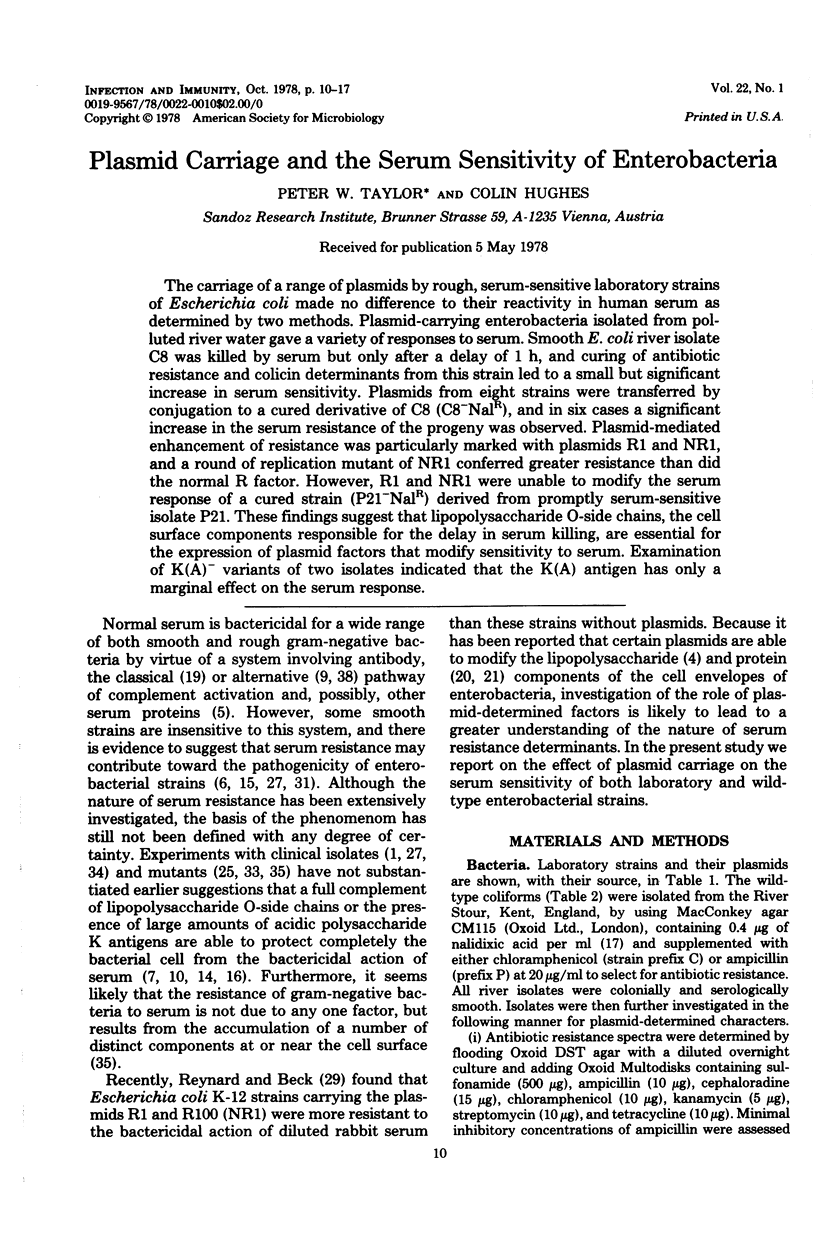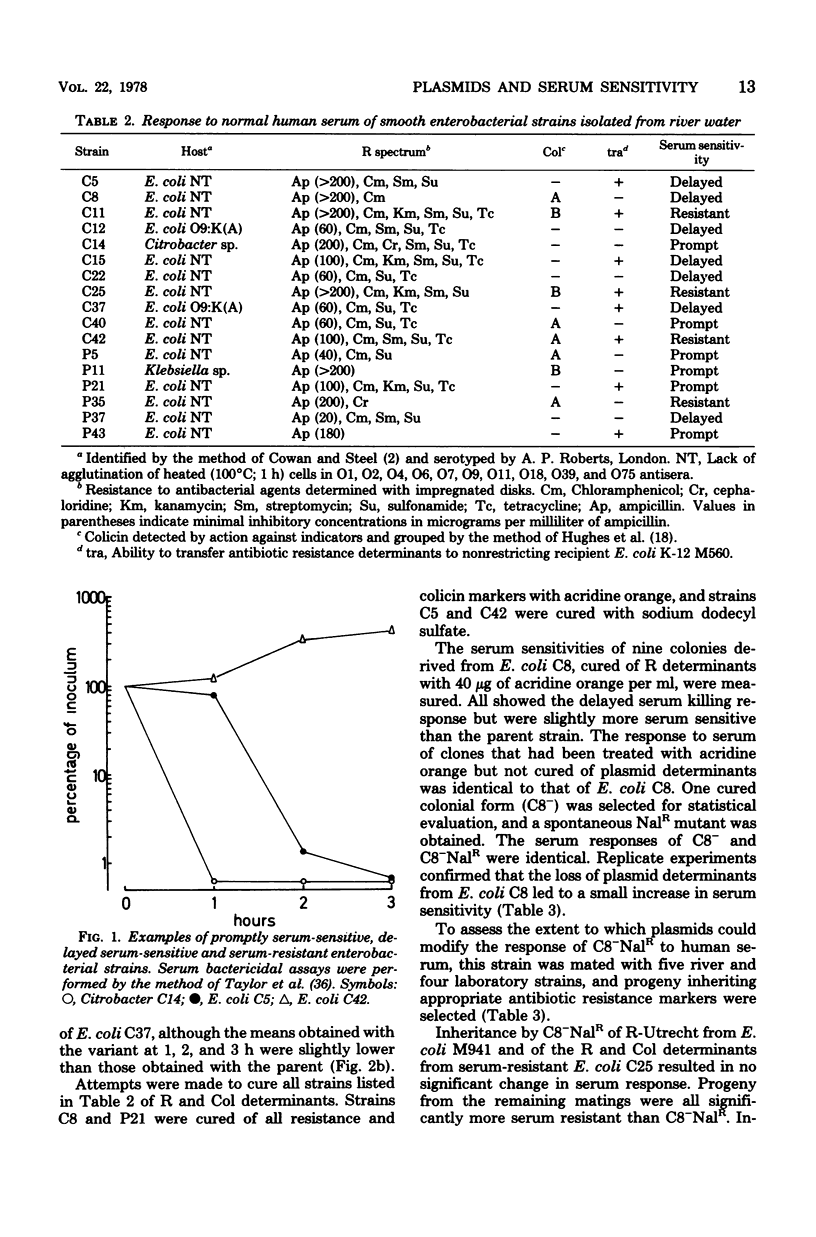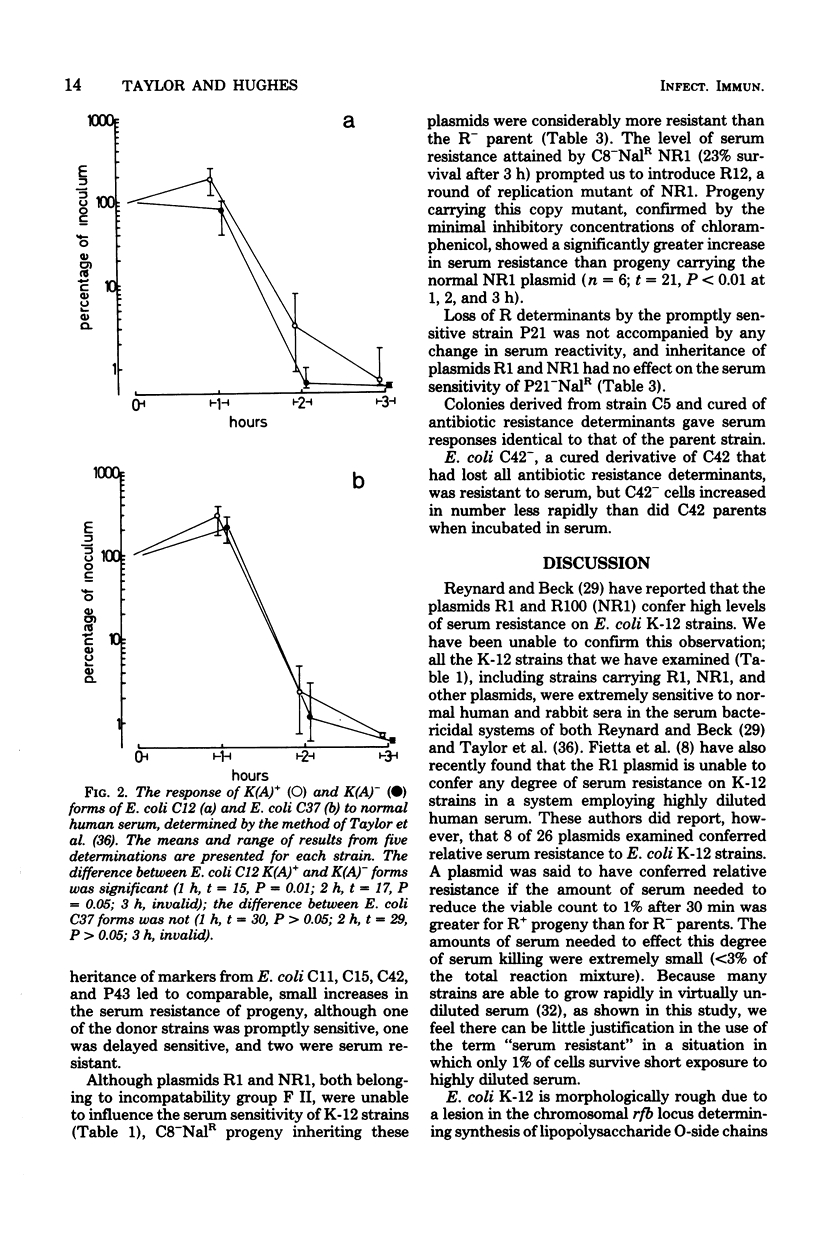Abstract
The carriage of a range of plasmids by rough, serum-sensitive laboratory strains of Escherichia coli made no difference to their reactivity in human serum as determined by two methods. Plasmid-carrying enterobacteria isolated from polluted river water gave a variety of responses to serum. Smooth E. coli river isolate C8 was killed by serum but only after a delay of 1 h, and curing of antibiotic resistance and colicin determinants from this strain led to a small but significant increase in serum sensitivity. Plasmids from eight strains were transferred by conjugation to a cured derivative of C8 (C8−NalR), and in six cases a significant increase in the serum resistance of the progeny was observed. Plasmid-mediated enhancement of resistance was particularly marked with plasmids R1 and NR1, and a round of replication mutant of NR1 conferred greater resistance than did the normal R factor. However, R1 and NR1 were unable to modify the serum response of a cured strain (P21−NalR) derived from promptly serum-sensitive isolate P21. These findings suggest that lipopolysaccharide O-side chains, the cell surface components responsible for the delay in serum killing, are essential for the expression of plasmid factors that modify sensitivity to serum. Examination of K(A)− variants of two isolates indicated that the K(A) antigen has only a marginal effect on the serum response.
Full text
PDF







Selected References
These references are in PubMed. This may not be the complete list of references from this article.
- Björkstén B., Bortolussi R., Gothefors L., Quie P. G. Interaction of E. coli strains with human serum: lack of relationship to K1 antigen. J Pediatr. 1976 Dec;89(6):892–897. doi: 10.1016/s0022-3476(76)80592-6. [DOI] [PubMed] [Google Scholar]
- Davies J. K., Reeves P. Genetics of resistance to colicins in Escherichia coli K-12: cross-resistance among colicins of group A. J Bacteriol. 1975 Jul;123(1):102–117. doi: 10.1128/jb.123.1.102-117.1975. [DOI] [PMC free article] [PubMed] [Google Scholar]
- Derylo M., Glowacka M., Lorkiewicz Z., Russa R. Plasmid-determined alterations of Salmonella typhimurium lipopolysaccharides. Mol Gen Genet. 1975 Sep 29;140(2):175–181. doi: 10.1007/BF00329785. [DOI] [PubMed] [Google Scholar]
- Durack D. T., Beeson P. B. Protective role of complement in experimental Escherichia coli endocarditis. Infect Immun. 1977 Apr;16(1):213–217. doi: 10.1128/iai.16.1.213-217.1977. [DOI] [PMC free article] [PubMed] [Google Scholar]
- Feingold D. S. The serum bactericidal reaction. IV. Phenotypic conversion of Escherichia coli from serum-resistance to serum-sensitivity by diphenylamine. J Infect Dis. 1969 Oct;120(4):437–444. doi: 10.1093/infdis/120.4.437. [DOI] [PubMed] [Google Scholar]
- Fietta A., Romero E., Siccardi A. G. Effect of some R factors on the sensitivity of rough Enterobacteriaceae to human serum. Infect Immun. 1977 Nov;18(2):278–282. doi: 10.1128/iai.18.2.278-282.1977. [DOI] [PMC free article] [PubMed] [Google Scholar]
- GRATIA J. P. R'ESISTANCE 'A LA COLICINE B CHEZ E. COLI. RELATIONS DE SP'ECIFICIT'E ENTRE COLICINES B, I ET V ET PHAGE T-4. ETUDE G'EN'ETIQUE. Ann Inst Pasteur (Paris) 1964 Nov;107:SUPPL–SUPPL:151. [PubMed] [Google Scholar]
- Glynn A. A., Howard C. J. The sensitivity to complement of strains of Escherichia coli related to their K antigens. Immunology. 1970 Mar;18(3):331–346. [PMC free article] [PubMed] [Google Scholar]
- Hartley C. L., Howe K., Linton A. H., Linton K. B., Richmond M. H. Distribution of R plasmids among the O-antigen types of Escherichia coli isolated from human and animal sources. Antimicrob Agents Chemother. 1975 Aug;8(2):122–131. doi: 10.1128/aac.8.2.122. [DOI] [PMC free article] [PubMed] [Google Scholar]
- Hirota Y. THE EFFECT OF ACRIDINE DYES ON MATING TYPE FACTORS IN ESCHERICHIA COLI. Proc Natl Acad Sci U S A. 1960 Jan;46(1):57–64. doi: 10.1073/pnas.46.1.57. [DOI] [PMC free article] [PubMed] [Google Scholar]
- Howard C. J., Glynn A. A. Diphenylamine induced complement sensitivity and associated changes in the antigenic structure of Escherichia coli. Immunology. 1971 Dec;21(6):951–955. [PMC free article] [PubMed] [Google Scholar]
- Howard C. J., Glynn A. A. Some physical properties of K antigens of Escherichia coli related to their biological activity. Infect Immun. 1971 Jul;4(1):6–11. doi: 10.1128/iai.4.1.6-11.1971. [DOI] [PMC free article] [PubMed] [Google Scholar]
- Howard C. J., Glynn A. A. The virulence for mice of strains of Escherichia coli related to the effects of K antigens on their resistance to phagocytosis and killing by complement. Immunology. 1971 May;20(5):767–777. [PMC free article] [PubMed] [Google Scholar]
- Hughes C. Nalidixic acid as a selective agent for the isolation of enterobacteria from river water. J Hyg (Lond) 1976 Aug;77(1):23–30. doi: 10.1017/s0022172400055479. [DOI] [PMC free article] [PubMed] [Google Scholar]
- Hughes V., Le Grice S., Hughes C., Meynell G. G. Two major groups of colicin factors: their molecular weights. Mol Gen Genet. 1978 Feb 16;159(2):219–221. doi: 10.1007/BF00270897. [DOI] [PubMed] [Google Scholar]
- Inoue K., Yonemasu K., Takamizawa A., Amano T. [Studies on the immune bacteriolysis. XIV. Requirement of all nine components of complement for immune bacteriolysis]. Biken J. 1968 Sep;11(3):203–206. [PubMed] [Google Scholar]
- Iyer R., Darby V., Holland I. B. Alterations in the outer membrane proteins of Escherichia coli B/r associated with the presence of the R plasmid rRM98. FEBS Lett. 1978 Jan 1;85(1):127–132. doi: 10.1016/0014-5793(78)81263-0. [DOI] [PubMed] [Google Scholar]
- Iyer R. Plasmid mediated alterations in composition and structure of envelopes of Escherichia coli B/r. Biochim Biophys Acta. 1977 Oct 17;470(2):258–272. doi: 10.1016/0005-2736(77)90105-5. [DOI] [PubMed] [Google Scholar]
- Meynell E., Meynell G. G., Datta N. Phylogenetic relationships of drug-resistance factors and other transmissible bacterial plasmids. Bacteriol Rev. 1968 Mar;32(1):55–83. doi: 10.1128/br.32.1.55-83.1968. [DOI] [PMC free article] [PubMed] [Google Scholar]
- Morris C. F., Hashimoto H., Mickel S., Rownd R. Round of replication mutant of a drug resistance factor. J Bacteriol. 1974 Jun;118(3):855–866. doi: 10.1128/jb.118.3.855-866.1974. [DOI] [PMC free article] [PubMed] [Google Scholar]
- Nelson B. W., Roantree R. J. Analyses of lipopolysaccharides extracted from penicillin-resistant, serum-sensitive salmonella mutants. J Gen Microbiol. 1967 Aug;48(2):179–188. doi: 10.1099/00221287-48-2-179. [DOI] [PubMed] [Google Scholar]
- Nomura M., Witten C. Interaction of colicins with bacterial cells. 3. Colicin-tolerant mutations in Escherichia coli. J Bacteriol. 1967 Oct;94(4):1093–1111. doi: 10.1128/jb.94.4.1093-1111.1967. [DOI] [PMC free article] [PubMed] [Google Scholar]
- Olling S. Sensitivity of gram-negative bacilli to the serum bactericidal activity: a marker of the host-parasite relationship in acute and persisting infections. Scand J Infect Dis Suppl. 1977;(10):1–40. doi: 10.3109/inf.1977.9.suppl-10.01. [DOI] [PubMed] [Google Scholar]
- Orskov I., Orskov F., Jann B., Jann K. Serology, chemistry, and genetics of O and K antigens of Escherichia coli. Bacteriol Rev. 1977 Sep;41(3):667–710. doi: 10.1128/br.41.3.667-710.1977. [DOI] [PMC free article] [PubMed] [Google Scholar]
- Reynard A. M., Beck M. E. Plasmid-mediated resistance to the bactericidal effects of normal rabbit serum. Infect Immun. 1976 Sep;14(3):848–850. doi: 10.1128/iai.14.3.848-850.1976. [DOI] [PMC free article] [PubMed] [Google Scholar]
- Schmidt G. Genetical studies on the lipopolysaccharide structure of Escherichia coli K12. J Gen Microbiol. 1973 Jul;77(1):151–160. doi: 10.1099/00221287-77-1-151. [DOI] [PubMed] [Google Scholar]
- Simberkoff M. S., Ricupero I., Rahal J. J., Jr Host resistance to Serratia marcescens infection: serum bactericidal activity and phagocytosis by normal blood leukocytes. J Lab Clin Med. 1976 Feb;87(2):206–217. [PubMed] [Google Scholar]
- Taylor P. W. Genetical studies of serum resistance in Escherichia coli. J Gen Microbiol. 1975 Jul;89(1):57–66. doi: 10.1099/00221287-89-1-57. [DOI] [PubMed] [Google Scholar]
- Taylor P. W. Immunochemical investigations on lipopolysaccharides and acidic polysaccharides from serum-sensitive and serum-resistant strains of Escherichia coli isolated from urinary-tract infections. J Med Microbiol. 1976 Nov;9(4):405–421. doi: 10.1099/00222615-9-4-405. [DOI] [PubMed] [Google Scholar]
- Taylor P. W., Parton R. A protein factor associated with serum resistance in Escherichia coli. J Med Microbiol. 1977 May;10(2):225–232. doi: 10.1099/00222615-10-2-225. [DOI] [PubMed] [Google Scholar]
- Taylor P. W., Roberts A. P., Gower P. E. Evaluation of a technique for the estimation of serum bactericidal activity against Gram-negative organisms. Med Lab Technol. 1972 Jul;29(3):272–279. [PubMed] [Google Scholar]
- Taylor P. W. Sensitivity of some smooth strains of Escherichia coli to the bactericidal action of normal human serum. J Clin Pathol. 1974 Aug;27(8):626–629. doi: 10.1136/jcp.27.8.626. [DOI] [PMC free article] [PubMed] [Google Scholar]
- Tomoeda M., Inuzuka M., Kubo N., Nakamura S. Effective elimination of drug resistance and sex factors in Escherichia coli by sodium dodecyl sulfate. J Bacteriol. 1968 Mar;95(3):1078–1089. doi: 10.1128/jb.95.3.1078-1089.1968. [DOI] [PMC free article] [PubMed] [Google Scholar]
- Traub W. H., Kleber I. Selective activation of classical and alternative pathways of human complement by "promptly serum-sensitive" and "delayed serum-sensitive" strains of Serratia marcescens. Infect Immun. 1976 May;13(5):1343–1346. doi: 10.1128/iai.13.5.1343-1346.1976. [DOI] [PMC free article] [PubMed] [Google Scholar]
- Wood W. B. Host specificity of DNA produced by Escherichia coli: bacterial mutations affecting the restriction and modification of DNA. J Mol Biol. 1966 Mar;16(1):118–133. doi: 10.1016/s0022-2836(66)80267-x. [DOI] [PubMed] [Google Scholar]


